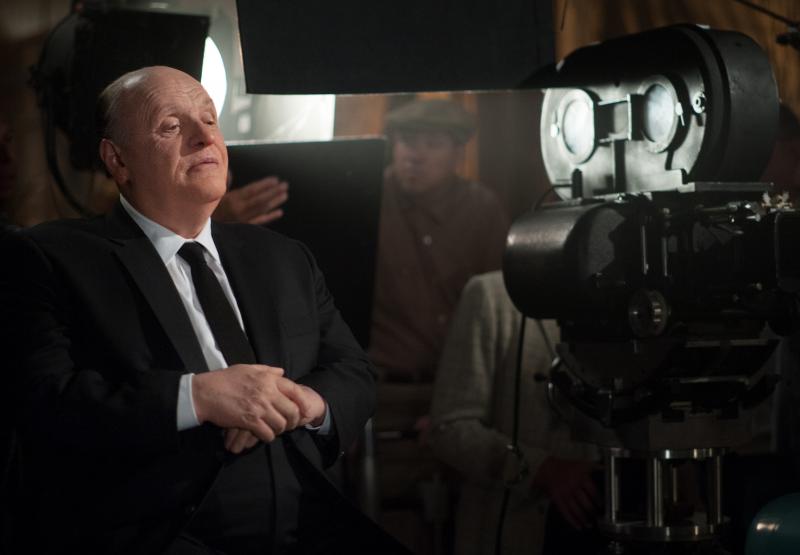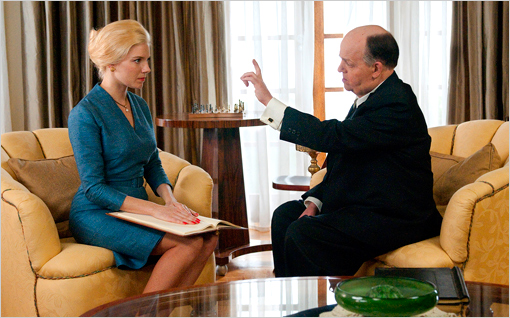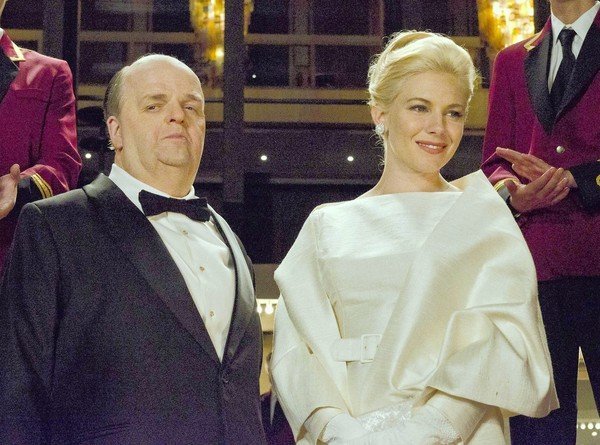In the wake of the release of Fox Searchlight’s long anticipated Alfred Hitchcock biopic, appropriately called Hitchcock, a different production about the master of suspense has flown under the radar. Home Box Office, in conjunction with the British Broadcasting Corporation, has made their own Hitchcock film, The Girl, which focuses on a darker side of the influential director.
In some ways, the films can be viewed as companion pieces; Hitchcock documents the making of Psycho, while The Girl picks up right where that film leaves off, showing the behind-the-scenes action for Hitch’s next two films, The Birds and Marnie. For what it’s worth, both films take liberties with the history behind their respective source material. Hitchcock, which is based on Stephen Rebello’s book “Alfred Hitchcock and the Making of Psycho,” is an underdog story, almost too much so; there is a definite “us-against-them” vibe to the production, but the “us” is Hitch and his wife, Alma, and the rest of the creative team around the film are relegated to bit parts and cameos. Designer Saul Bass, who many feel actually directed the infamous shower scene in Psycho, is barely present at all. Screenwriter Joseph Stefano, who masterfully adapted Robert Bloch’s novel for the screen, is short changed as well. Composer Bernard Herrmann, who wrote Psycho’s iconic score, at least gets credit for his contribution in his scene, but is still hardly shown in the film at all. While Rebello’s book clearly defines and acknowledges these important contributions to Psycho, Hitchcock does not; it makes Psycho out to be a one-man (and one-woman) show, and the absence of recognition for Hitch’s collaborators is a huge disrespect. The inspiration for Norman Bates, serial killer Ed Gein, gets more screen time than Bass, Stefano and Herrmann combined. Hitchcock puts the entirety of Psycho on Hitch and Alma, and while they were the chief financiers and driving forces behind the film, no man is an army, and Hitch’s soldiers get left behind.

The Girl, on the other hand, is much like a film that Alfred Hitchcock himself would have made. Based on the later chapters of Donald Spoto’s “Spellbound by Beauty: Alfred Hitchcock and His Leading Ladies,” it focuses chiefly and solely on Hitch’s obsession with Tippi Hedren. It speculates, in shocking detail, about the horrible treatment and torture through which Hitch would put Hedren. Hitch and Hedren had a complicated relationship; she saw him as her meal ticket and, according to Hedren, he became obsessed with her. His abuse of the actress, both physically and emotionally, has been well documented and, in The Girl, is committed to the screen. Much of Hitch’s malevolence is probably exaggerated in The Girl, but the only one who knows for sure is Tippi Hedren. One thing that is for sure, however, is that it’s a very dark and disturbing movie, with Hitch playing the role of antagonist to Hedren’s heroine.

Most of the attention in both films is given to the actors who landed the starring role, Alfred Hitchcock himself. In Hitchcock, the audience is treated to a performance that is nothing short of amazing by the one and only Anthony Hopkins. Similar to the way that Michelle Williams portrayed Marilyn Monroe in My Week with Marilyn, Hopkins actually becomes Hitchcock – his vocal inflections, body language, even the drastic transformation of shape (it looks like Hopkins gained sixty pounds for the film, if it’s a fat suit, it’s a really convincing one) all combine to make the viewer forget that they’re watching Hannibal Lecter. It’s only Hitchcock on the screen. The Girl gives the part of the master to Toby Jones, who, to his credit, has the voice and mannerisms down, but is hampered by a hilariously bad sumo suit and terrible makeup. No matter how good the performance is, the appearance is distracting, and poor Toby Jones looks ready to just melt in that getup. The Hitchcock to which audiences are treated is completely different in the two films; Hitchcock’s title character is confident and benevolent while The Girl’s main man is cocky and egotistical. There is truth in both portrayals, and the real life Hitch probably fell somewhere in the middle, but fans of the man will want to buy into Hopkins’ character study while critics will believe in Jones.

Alfred Hitchcock’s leading ladies factor heavily into both productions. Hitch’s real life relationships with his stars are an important part of both stories. Notoriously tough and demanding on his actresses, the Hitch in Hitchcock is friendly and kind to his girls while the director in The Girl is cruel and cold. In Hitchcock, Vera Miles (who had history with Hitch, having worked with him on The Wrong Man as well as in an episode of “Alfred Hitchcock Presents,” and having lost the female lead in Vertigo because of her pregnancy) is shown cautioning Janet Leigh about Hitch, but because the viewer only sees the kinder, gentler Hitchcock, Miles ends up looking more like the bad guy for giving the unwarranted advice. There is no such warning in The Girl, and Tippi Hedren sees her opportunity to work with Hitchcock that she believes to be a dream come true quickly turn into a nightmare. In working with the women, Hitchcock uses his directorial experience to coax a convincing performance out of Leigh in Psycho while he resorts to physical cruelty and terror to get a suitable reaction from Hedren in The Birds. Maybe it’s because Hitch has more faith in her ability as an actress, or maybe because she actually is more talented, but Janet Leigh gets off much easier than Tippi Hedren in her experiences with Alfred Hitchcock.

The strongest aspect of The Girl is Sienna Miller, who is tasked with playing Tippi Hedren. She is a capably strong protagonist, one worth rooting for while she initially puts up with, then stands up to, Hitch’s abuse. The girls in Hitchcock, Jessica Biel as Vera Miles and Scarlet Johansson as Janet Leigh, are great as well, although used in a more limited capacity so they don’t get to flex their artistic muscles as much as Miller does. Nevertheless, in a pair of pictures about a director who obsessed over and thrived because of his leading ladies, all of the actresses are well represented.

Another interesting thing about both films is how they deal with their subject films’ trademark scenes. Two of the best scenes in Hitchcock deal with Psycho’s shower scene, while one of the most memorable scenes in The Girl revolves around the shooting of the phone booth scene from The Birds. In Hitchcock, Hitch is shown taking the prop knife away from his stunt killer and doing the stabbing himself. The scene is presented with the same rhythm and cadence as the shower scene, and it has a similar emotional effect by the end – the audience wonders, has the pressure of producing his own film caused the great man to crack? Hitch grabbing the knife himself surprises Janet Leigh and provokes a stunning performance from the actress. Later, at the premiere, Hitch leaves the auditorium and goes to the lobby of the theater during the scene in question. Knowing the scene like the back of his hand, he conducts the on-screen audience’s reactions like a musician, accenting every gasp and scream with a wave and a punch. With everything on screen and not in his hands, the man is at peace with himself and his film, confident that the scene will get its intended response from the audience. Rather than bore the audience with technical aspects of the scene that are found in Rebello’s book, the film treats the legendary scene with respect and dignity. In The Girl, the shooting of the phone booth scene is used as a tool to illustrate just how heartless and cruel Hitch was to Hedren; he deliberately sabotages the props to coax a more inspired performance out of her, practically scaring her to death in the process. This is the Hitch that Hedren feared, and the one that The Girl portrays; heartless, cruel and prioritizing his creative output over the well being of his charges. Even the film crew is horrified as they stand idly by and watch the master of suspense become Hedren’s master of terror, seemingly afraid to cross the man and come to her aid. While both Hitchcock and The Girl demonstrate the immense respect that Hitch commanded, the director comes off looking positive in Hitchcock and negative in The Girl.

With Hitchcock and The Girl, audiences are given not only two very different movies, but two very different imaginings of Alfred Hitchcock. Hitchcock is a funny, uplifting film that portrays Hitch as a “can’t fail” hero, while The Girl is a dark, dreary movie that looks at the man as villain. Both films show a man who will go to the ends of the Earth to get the results that he wants, but they show very different opinions of how he goes after those results. For Hitchcock fans, both movies are interesting, and both are controversial in their own, historically liberal ways.
